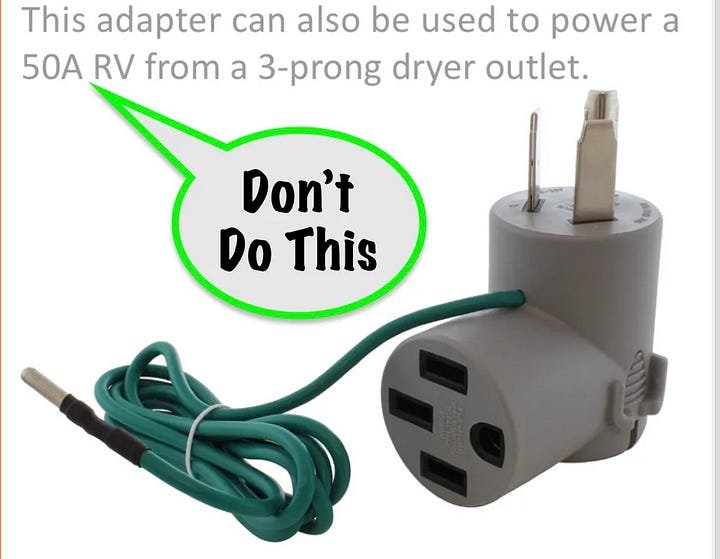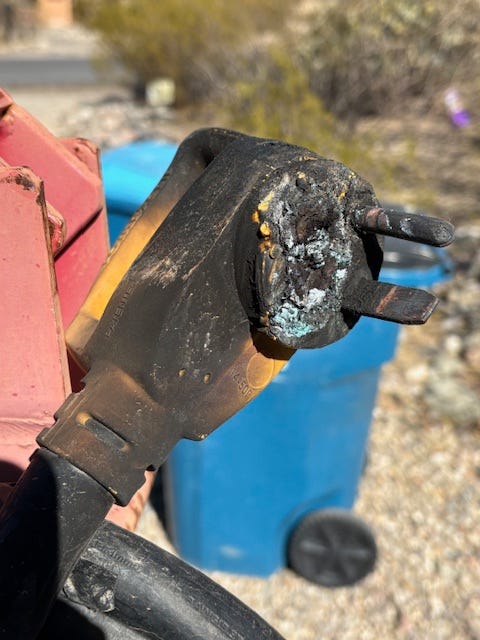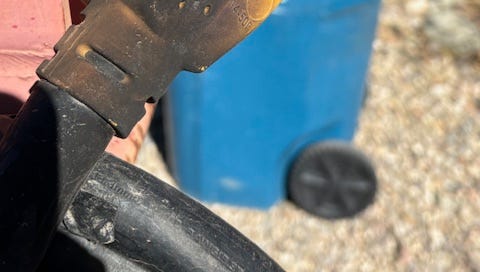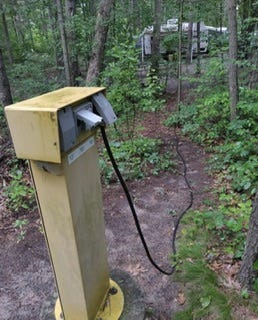How far is too far?
How much voltage drop occurs when you add an extension cord to your shore power cord? Please take this survey!
Dear Readers,
Here’s a picture of a burned 50-amp plug that was connected to a 30-amp dryer outlet adapter with 50 ft, 30-amp extension cord and a 50-ft, 50-amp extension cord feeding a 50-ft shore power cord. Yes, it’s confusing.


That’s right… 150 ft of power cord. And this was powered from a 30-amp, 2-pole dryer outlet using a special adapter with a separate ground wire. I should note that a 3-wire, 240-volt welder or dryer outlet adapter is a code violation with a potential for over-voltage damage to your RV if the dryer outlet neutral is undersized.
This got me thinking about excessive voltage drop in properly wired 30-amp hookups due to extending the shore power cord to reach a distant pedestal. Once the voltage at your RV gets down below 105 volts, damage to your Air Conditioner and residential refrigerator compressor can occur due to excessive current draw. In fact, I’ve measured power at the RV on a long shore power hookup below 100 volts.
Here’s the numbers
So what happens to the voltage at your RV when you add 25, 50, 75, 100 or even 200 ft of 10-gauge extension cord to a 30-amp outlet? Let’s assume the pedestal can maintain a full 120-volts at 30-amps which is probably optimistic.
Let’s try 25 ft
How about 50 ft
Now let’s add 75 ft
What happens with 100 ft
Let’s go nuts with 200 ft
Why does this happen?
Voltage drop over a conductor only occurs when current is flowing. So with zero amperes of current there will be zero loss of volts. That means if the pedestal has 120-volts, then your RV would have 120-volts. But if the pedestal only has 110-volts to begin with, then the max voltage at your RV will be 110 volts.
But when your air conditioner and electric water heater come on at the same time, that’s probably 20+ amperes of current. And that amount of amperage can create a significant voltage drop over a long shore power cord. The result is that you could lose 5, 10 or even 20 volts (or more) over a long extension cord if your RV is drawing a lot of current. I’ve even seen an 200-ft run of 14-gauge extension cord with 30-amp adapter that ended up with 90 volts at the RV according to a Hughes Watchdog. And that’s a recipe for Air Conditioner failure or a meltdown!
Shorter and bigger is better!
If you have to hook up to a distant pedestal outlet, then use the shortest and heaviest extension cord available. And always clean the connectors with contact cleaner before plugging in. Both CRC and DeoxIT make great contact cleaning products.
Please take this survey
So what’s the longest you’ve had to run your shore power cord to plug into a pedestal outlet? Please add your normal shore power cord (usually 25 feet) plus whatever extension cord you needed. For example, if you had to add a 25 ft extension cord to your 25 ft shore power cord, then that would be 50 ft. If you only use your RV’s 25 ft shore power cord, please enter 25 ft. And add info on any special hookups in the comments below.
Let’s play safe out there - Mike












2x100' 10ga extension cord + 25' 8ga cord + 25' shore power cord. Used at my camp for many years until I could get service installed at my pole barn and RV. I used only one appliance at a time, like a space heater or microwave. Never the AC. I even turned off all lights to use the microwave. Never had a problem.
Our RV has 30 amp service. We have the following cords:
* ~20 foot #10 gauge shore power cord
* 25 foot #10 gauge extension
* 100 foot #10 gauge extension
We owned the RV for years before buying the 100' cord. The reason was that we were visiting relatives in Gilbert (Phoenix area) and not only was it over 100*F, but they had just had monsoon rains, so it was HUMID! We could have stayed in their house, but one main reason we bought the RV was to avoid that. The outlet was on a 15A circuit. I wasn't sure if it would be able to handle the A/C for an extended period without tripping, but it did. We have a Progressive Industries EMS with a display, so I was able to monitor the voltage and current. The lowest the voltage got was 109V, the max current was 12-13 amps. I can't recall the no-load voltage, but it was pretty decent, maybe 118V. As it cooled off, the current draw dropped to maybe 9-10A, and the voltage increased.
In short, the 100 foot #10 extension + the factory shoer power cord (~120 feet total) worked well -- but that was a max load of 13A. Much more and the EMS would have cut the connection (low voltage cut-off is about 107V).
We've never used both the 100' and 25' extensions together. In fact, the only time we use the 100' cord is when staying with family and friends. We've almost never been to a campground where an extension was necessary. We may have used the 25' extension once.